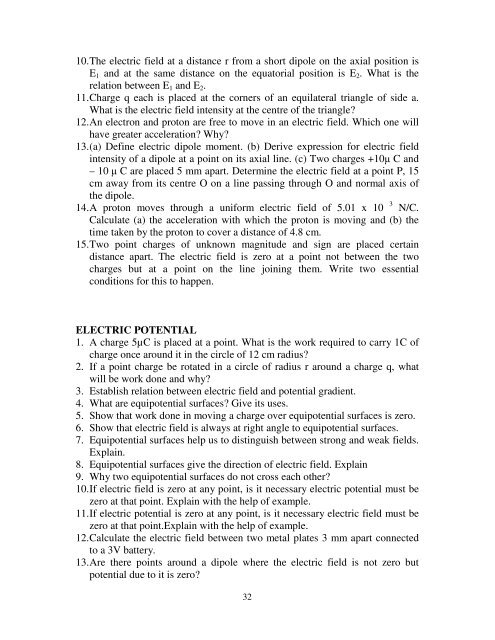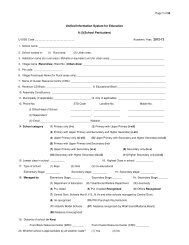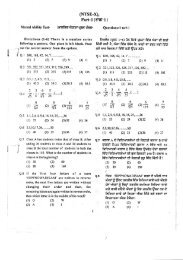SUBJECT : PHYSICS - SSA Punjab
SUBJECT : PHYSICS - SSA Punjab
SUBJECT : PHYSICS - SSA Punjab
You also want an ePaper? Increase the reach of your titles
YUMPU automatically turns print PDFs into web optimized ePapers that Google loves.
10. The electric field at a distance r from a short dipole on the axial position isE 1 and at the same distance on the equatorial position is E 2 . What is therelation between E 1 and E 2 .11. Charge q each is placed at the corners of an equilateral triangle of side a.What is the electric field intensity at the centre of the triangle?12. An electron and proton are free to move in an electric field. Which one willhave greater acceleration? Why?13. (a) Define electric dipole moment. (b) Derive expression for electric fieldintensity of a dipole at a point on its axial line. (c) Two charges +10µ C and– 10 µ C are placed 5 mm apart. Determine the electric field at a point P, 15cm away from its centre O on a line passing through O and normal axis ofthe dipole.14. A proton moves through a uniform electric field of 5.01 x 10 3 N/C.Calculate (a) the acceleration with which the proton is moving and (b) thetime taken by the proton to cover a distance of 4.8 cm.15. Two point charges of unknown magnitude and sign are placed certaindistance apart. The electric field is zero at a point not between the twocharges but at a point on the line joining them. Write two essentialconditions for this to happen.ELECTRIC POTENTIAL1. A charge 5µC is placed at a point. What is the work required to carry 1C ofcharge once around it in the circle of 12 cm radius?2. If a point charge be rotated in a circle of radius r around a charge q, whatwill be work done and why?3. Establish relation between electric field and potential gradient.4. What are equipotential surfaces? Give its uses.5. Show that work done in moving a charge over equipotential surfaces is zero.6. Show that electric field is always at right angle to equipotential surfaces.7. Equipotential surfaces help us to distinguish between strong and weak fields.Explain.8. Equipotential surfaces give the direction of electric field. Explain9. Why two equipotential surfaces do not cross each other?10. If electric field is zero at any point, is it necessary electric potential must bezero at that point. Explain with the help of example.11. If electric potential is zero at any point, is it necessary electric field must bezero at that point.Explain with the help of example.12. Calculate the electric field between two metal plates 3 mm apart connectedto a 3V battery.13. Are there points around a dipole where the electric field is not zero butpotential due to it is zero?32
















